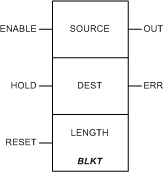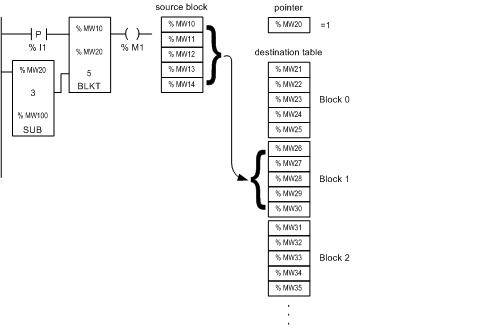|
|
(Original Document)
|
|
Name in LL984 Editor
|
Function Block Name
|
|---|---|
|
name of legacy 984 instruction
|
name in other tools and editors like:
|
 |
 |
 WARNING WARNING |
|
CORRUPTED DATA
Use external logic in conjunction with the middle or bottom input to confine the value in the pointer to a range of memory words that has been determined to be safe in your application.
Failure to follow these instructions can result in death, serious injury, or equipment damage.
|

|
Input Pin
|
Name
|
Data Type
|
Address Range
|
Meaning
|
|---|---|---|---|---|
|
Top
|
ENABLE
|
–
|
OFF to ON initiates the operation.
|
|
|
Middle
|
HOLD
|
BOOL
|
–
|
ON= hold pointer
OFF= increment pointer
|
|
Bottom
|
RESET
|
BOOL
|
–
|
ON= reset pointer to zero
|
|
Node
|
Node Type
|
Name
|
Data Type
|
Address Range
|
Meaning
|
|---|---|---|---|---|---|
|
Top
|
IN
|
SOURCE
|
ANY_ARRAY_UINT
|
%MW
|
The source block declared as ARRAY[1..x] OF UINT, where x is the value of LENGTH.
|
|
Middle
|
IN/OUT
|
DEST
|
ANY_ARRAY_UINT
|
%MW
|
The pointer word followed by a sequence of blocks, each of which has the same size as the source block. To be declared as ARRAY[1..(n*LENGTH)+1] OF UINT, where n is the count of blocks in the destination table and LENGTH is the value of the LENGTH parameter. The result of (n*LENGTH)+1 is represented as a constant.
|
|
Bottom
|
IN
|
LENGTH
|
UINT
|
1...100
|
The number of words to be included in the operation.
Valid range: 1 to 100.
|
|
Output Pin
|
Name
|
Data Type
|
Address Range
|
Meaning
|
|---|---|---|---|---|
|
Top
|
OUT
|
BOOL
|
–
|
ON indicates the operation succeeded.
|
|
Middle
|
ERR
|
BOOL
|
–
|
ON indicates the attempted operation is not possible.
|
